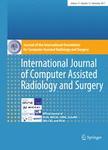版权所有:内蒙古大学图书馆 技术提供:维普资讯• 智图
内蒙古自治区呼和浩特市赛罕区大学西街235号 邮编: 010021

作者机构:Shanghai Univ Tradit Chinese Med Sch Basic Med 1200 Cailun Rd Shanghai 201203 Peoples R China Shanghai Univ Tradit Chinese Med Shanghai Collaborat Innovat Ctr Hlth Serv Tradit 1200 Cailun Rd Shanghai 201203 Peoples R China Xiamen Univ Dept Intelligent Sci & Technol 422 South Siming Rd Xiamen 361005 Fujian Peoples R China
出 版 物:《INTERNATIONAL JOURNAL OF COMPUTER ASSISTED RADIOLOGY AND SURGERY》 (国际计算机辅助放射学与外科学杂志)
年 卷 期:2020年第15卷第2期
页 面:203-212页
核心收录:
学科分类:0831[工学-生物医学工程(可授工学、理学、医学学位)] 1006[医学-中西医结合] 1002[医学-临床医学] 1009[医学-特种医学] 10[医学] 100602[医学-中西医结合临床]
基 金:National Natural Science Foundation of China [81373556, 81102558, 81873235] National Key Research and Development Program of China [2017YFC1703300, 2017YFC1703301]
主 题:Tongue image-based diagnosis Principal component analysis K-Means 2D clustering Visual application
摘 要:Purpose Studies have shown the association between tongue color and diseases. To help clinicians make more objective and accurate decisions quickly, we take unsupervised learning to deal with the basic clustering of tongue color in a 2D *** total of 595 typical tongue images were analyzed. The 3D information extracted from the image was transformed into 2D information by principal component analysis (PCA). K-Means was applied for clustering into four diagnostic groups. The results were evaluated by clustering accuracy (CA), Jaccard similarity coefficient (JSC), and adjusted rand index (ARI).ResultsThe new 2D information totally retained 89.63% original information in the L*a*b* color space. And our methods successfully classified tongue images into four clusters and the CA, ARI, and JSC were 89.04%, 0.721, and 0.890, *** 2D information of tongue color can be used for clustering and to improve the visualization. K-Means combined with PCA could be used for tongue color classification and diagnosis. Methods in the paper might provide reference for the other research based on image diagnosis technology.